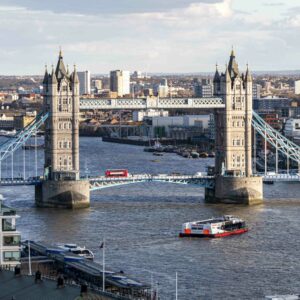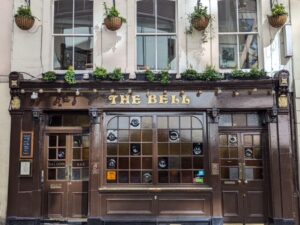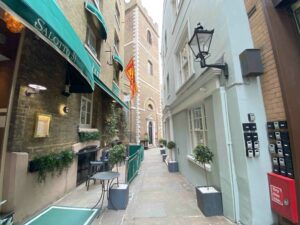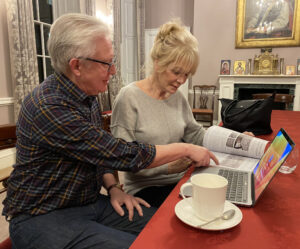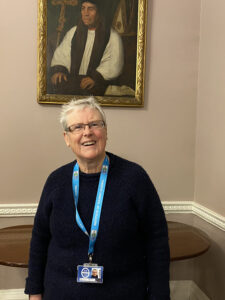This year St Bartholomew’s Hospital celebrates 900 years of continuous service on its Smithfield site. Founded in 1123, this great institution has survived the Black Death, the Reformation, the Plague, two world wars, threats of closure, and over time has transformed into the pioneering cancer and heart disease centre it is today.
To mark this extraordinary anniversary, Barts is currently hosting an exhibition which tells the story of the hospital through documents and photographs found in its extensive archives. Do pop in and take a look if you’re passing – or why not grab a coffee now, and enjoy this miscellany of highlights and curiosities.
Early Days
Rahere, a favourite courtier of Henry l founded St Bartholomew’s in 1123 as a priory and hospital where brethren and sisters cared for the poor and sick. There were just 45 beds initially and treatment was mainly spiritual as there was little or no medical knowledge.
As early as 1170 the hospital agreed to take in orphans and foundlings along with the homeless and sick. Travellers could also find shelter for the night. By the 13th century the hospital was taking in babies born at Newgate prison nearby and was educating boys in its hospital school.
Bread, beef and beans were on the menu in the 1300s – plus half a gallon of beer a day per person. Land owned by the hospital helped supply food and drink, catering for hungry patients and staff.
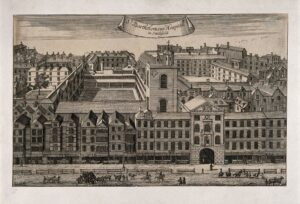
The Reformation
In 1539 the priory was closed by Henry Vlll as part of the dissolution of the monasteries, and so caring for the sick within a monastic framework came to a halt. The king responded to public pressure to keep it open and re-founded the hospital in 1546 as a secular enterprise, granting it to the City of London along with endowments to keep it running and provision for 100 beds. There was now a hospital president, a treasurer, and a board of governors as well as a Matron, nurses, steward, porter and 8 beadles.
Sisters and Nurses and Keeping it Clean.
Following the re-founding it was declared that there should be ‘one Matron and twelve women under her (known as sisters as they had been in medieval times) to make the beds and wash and attend upon the patients.’ Each sister oversaw one ward, and it was her job to fetch coal and provisions, empty the slops and generally keep the ward as clean as possible. Sisters would even spin flax to make bedsheets. Sheets and patients’ clothing were cleaned in a large wooden vat using wood-ash that the sisters had to supply themselves; soap was not used until 1687.
By the 1650s the sisters had helpers who came to be known as nurses. Sisters and nurses were required to be single or widowed and many worked into old age. Drunkenness and disorderly behaviour were not entirely uncommon, although the main problem seemed to be that most nurses had little education and no skill. That would change in the second half of the 18th century.
A variety of tradespeople were employed to meet the hospital community’s many needs, including Barbara Adams, who worked for over a decade as Barts’ first barber. She earned 27 pounds and eighteen shillings a year ‘shaving patients by order of the surgeons.’ In 1761 Barbara lost her job and her rented home next door to the hospital when she was fired for ‘improper conduct on diverse occasions.
Nursing Pioneers
Ethel Bedford Fenwick was Matron at Barts from 1881 to 1887 and campaigned for professionalism in nursing. She promoted a new understanding of disease transmission and high hygiene standards reflected by a new uniform and cap.
A school of nursing was founded at Barts in 1877. It was rudimentary in the early days with lessons on bandaging, bed-making and poultice-making, and although one of the trainees was taught how to take a temperature this was not considered a suitable job for a nurse.
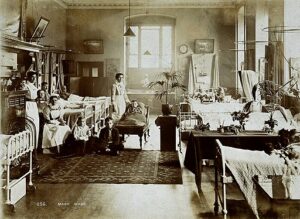
Isla Stewart took over as Barts’ Matron in 1887. A respected pioneer of nursing education, Stewart created a four-year training system at Barts and founded the League of St Bartholomew’s Hospital Nurses, still running today.
New ideas, new treatments
The 17th and 18th centuries saw the development of scientific ideas, new treatments and technologies. While physician to Barts in 1628, William Harvey was the first to describe how blood circulates between our heart and lungs. Percivall Pott and John Abernethy developed important principles of modern surgery in the 18th century,
In 1847, anaesthetics were first used at Barts, initially for tooth extraction. By 1850 anaesthetics had been administered at the hospital 7,000 times.
The Massage and Movement department, started in 1905 offered early physiotherapy techniques. The hospital’s electrical department, founded some decades earlier, used electrical currents to diagnose and treat muscle paralysis as well as for other experimental treatments.
The hospital has for many years pioneered new cancer treatments. Britain’s first million-volt radiotherapy machine was built here in 1937, housed in a purpose-built x-ray therapy wing.
The Gatehouse
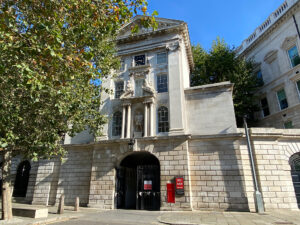
The Henry VIII Gatehouse is the oldest entrance to the hospital. It was designed and built in a Baroque style by the Strong family of masons between 1701 and 1702 and boasts the only statue of Henry Vlll on public view in the City.
It was outside the gate that one of Barts’ most infamous characters, William Salmon, plied his trade. Known as the ‘King of the quacks’, he sold an ‘elixir of life’ and ‘anti nymphomaniac lemonade’ to patients and passers-by.
St Bartholomew the Less
The only medieval building now remaining at Barts is the tower of the Church of St Bartholomew the Less. Formerly a chapel of the priory, the church is now part of the parish of Great St Bartholomew. The Rules for Patients in 1870 ordered that ‘every patient who may be able, shall attend the Divine Service on the Sunday morning at the Church of St Bartholomew the Less, if not contrary to their religious principles’.
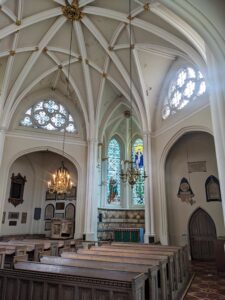
Rebuilding St Bartholomew’s Hospital
In 1729 the architect James Gibbs (who had previously completed St Martin in the Fields) was appointed to remodel the hospital, with the central square located in roughly the same position as the hospital’s medieval cloister. The new buildings were designed to reduce the risk of fire and increase air circulation.
Money for the project was raised by subscriptions and donations. A donation of £50 would give life membership, with the names of benefactors dating back to 1547 displayed on the walls of the Great Hall in the North Wing.
The hall was originally used as a meeting place for the Board of Governors, (as well as a useful place to dry the hospital laundry, as governors were shocked to discover one drizzly day in 1766). After the board was abolished in 1974 the hall has mainly been used for ceremonial occasions, concerts, and social functions.
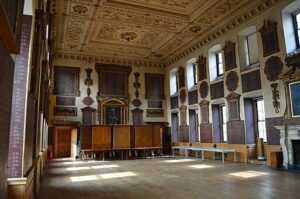
On the walls of the main staircase leading up to the Great Hall are two murals painted by locally born William Hogarth: The Pool of Bethesda and The Good Samaritan. When the hospital announced plans to commission art from Italian painters, Hogarth was so incensed, that to prove that English painting was equal to the task he insisted on painting the murals without a fee.
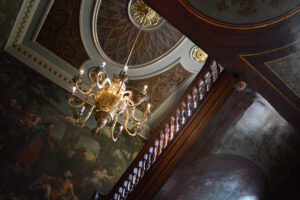
Barts relied on donations for every penny spent right up until 1948 when the government took over funding through the national Health Service. Everyone had given to Barts over the centuries – from Kings and Queens to pub landlords and sailors. Many City businesses sponsored a Barts bed with a wooden plaque placed directly above it on the ward.
The hospital’s water supply was improved by the building of a well in the hospital square in 1809 with a utilitarian central pump which Charles Dickens would later describe in 1851 as ‘ugly’ and resembling ‘a slice of a worn-out steam boiler with a lamp on top.’
Someone must have been listening as it was replaced in 1859 by the beautiful fountain we see there today – a favourite spot in all weathers. The fountain has provided the backdrop for many occasions over the years, and today the square along with the fountain at its centre offers a place for quiet reflection for patients and staff alike.
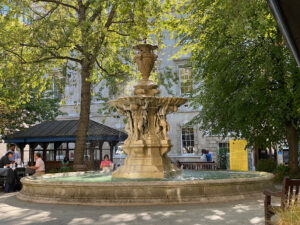
Back from the Brink…
In 1993 the controversial Tomlinson Review concluded that there were too many hospitals in central London. Barts was identified as a hospital with a low catchment area and was threatened with closure which led to an international campaign to ‘Save Barts’.
Today, following significant investment and redevelopment, Barts is expanding and thriving with a special focus on cardiac and cancer care (Barts Heart Centre is Europe’s largest specialised cardiovascular centre), and along with the medical school’s significant research and teaching facilities, St Bartholomew’s Hospital continues to provide world-class healthcare for the diverse populations of north and east London, and beyond.

